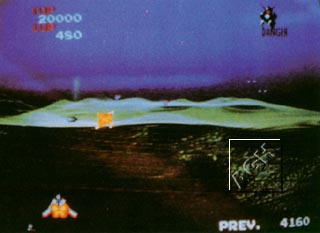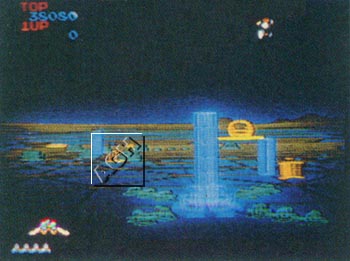INTERSTELLAR
By Funai

Less intense than M.A.C.H 3 but much more beautiful to look at,
Japanese-maker Funai's Interstellar (also known as "Interstellar
Fantasy") sports around 40 different laserdisc backgrounds depicting
alien cityscapes and fantasy works, all keyed to a moody, Tangerine
Dream-like synthesizer soundtrack that rates as one of the best music
ever heard in a videogame. The laser images (designed by Japanese
computer-graphics house Gakken) are a hard-edged, brilliantly colored
and seamless Space Odyssey phantasmagoria of frozen planets spinning
in the void, mountanous desert landscapes criss-crossed by what look
like forcefield grids, odd clusters of skeletal buildings that may
or may not be spaceports, etc. Superimposed on the Welcome-to-Jupiter
backgrounds is a fairly standard alien-blasting video game, modeled
after Galaga lines but with some novel additions, such as a feature
that lets you fire at different angles instead of only straight
ahead, and bombing sequences that follow the alien attack runs
at regular intervals.
In Interstellar, you control a bottom-screen spaceship, the "Ferald
Runner," and combat hordes of hostile for points in each of an
assortment of colorful worlds. As in most laserdisc games, all of
the backgrounds are disc-based; each planet is nicely represented
by a combination of computer animation and special effects film
footage. The spaceship and all of the game's adversaries are
generated by the machine's computer hardware. The Ferald Runner
is armed with both rapid-fire lasers (controlled by either a
joystick-mounted trigger or a console-mounted "Fazer" button) and
bombs (dropped by pressing the console-mounted "Burn" button).
As the contest begins, you blast off from your home base and head
for space (in an attractive computer-animated scene). You're then
transported to your first alien world, where you fly over a hilly
landscape that is blanketed with computer-generated contour lines.
Immediately, squadrons of hostile spaceships appear in the distance
on the horizon. The aliens will fly and swoop torwards your ship
in the foreground and attempt to crash into it kamikaze-style before
they fly off of the bottom of the screen. If an alien crashes
into the Ferald Runner, you'll lose one of your three initial
ships (bonus ships are earned at prset intervals). Points are
scored, as you would imagine, by blasting the alien attackers with
your lasers. Bonus points, meanwhile, may be earned by destroying
four alien ships in rapid successions. This actually isn't very
difficult (at least not in the first wave) -- you can often wipe
out an entire formation before they clear the horizon if you're
quick on the trigger.

After clearing the skies of attackers, you'll be whisked to the
second alien world featuring dark, crystalline landscape that is
brightened by intermittent energy beams. here, the battle
becomes more involving as you're pitted against two different
types of attackers; swarms of Galaxian-like fighters that
swoop and dive at you, and formations of bomb-dropping flying
saucers the cruise overhead. Since the saucers fly out of
your effective firing range, the best you can do is avoid the
bombs that they drop. Later in the wave, clusters of land-mounted
bases appear on the planet's surface and the overhead bombers
take a well-earned rest. These bases can be destroyed by aligning
them with a set of on-screen crosshairs and pressing the bomb-releasing
"Burn" button (while, at the same time, continuing to do battle
with the kamikaze fighters).
The third planet is an eerie world made up of hypnotically-swirling
colorful nebulae. Here, the swarms of diving alien fighters and
bomb-dropping saucers are joined on the screen by armies of land-based
moving tanks. If you survive long enough, they are later joined
by yet another enemy, the Delta UFO. The UFO is a large, triangular
spaceship that swoops in from the distance to directly attack the
Ferald Runner. This powerful craft can only be destroyed by landing
eight direct hits in the notch located on the nose of the UFO.
The 3-D game graphics (aliens get bigger the closer they get to you)
are well done and hi-res enough not to look out of place against the
laser background, and the laser sequences change with next to no
visible gaps. But while Interstellar is a fulsome trip for the eyes
and ears -- and fun to play just for the reward of seeing new sequences
and hearing more music -- the retread gameplay kept it from ever
becoming an arcade hotshot's delight.
|




